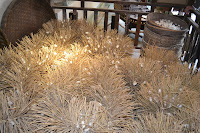 |
| Gondolla's and Fangsheng Bridge |
Zhujiajiao is a water canal town and is every thing you could imagine 'old China' to look like. So on one of our last days in Shanghai we ventured out on our own to see it, wanting the challenge - as Uncle Vic who lives in Shanghai was busy looking after sick cousin Flynn.
 |
| Our driver was racing Alex's rickshaw - we had the lighter load! |
 |
| Arriving in Zhujiajiao |
Zhujiajiao is situated on a water canal 30 km west from Shanghai, it was during the Ming dynasty it flourished as a commercial centre. What remains today is a mix of Ming and Qing dynasty shopping alley ways, stone bridges and old town architecture. Of all its bridges the Fangsheng Bridge stands out, built in 1571 it spans 72 m has five arches and is the most photographed.
 |
| Lots of live turtles, snails and fish for sale. |
 |
| Watch out for the turtle man - he has a stick! |
 |
| No point trying to escape! |
Zhujiajiao is about 1hr out of town by local bus. The adventure started just as we got settled in our seats. A fight broke out between an old Chinese lady who it appeared was unhappy about her seat allocation. Yelling ensued with the driver and included the people at the front of the bus and us the only Westerners on it, she was waving her hands about and getting very agitated. In the end she shuffled off to her seat at the back of the bus only once some other people moved and we showed her our seat numbers were correct. Phew!
 |
| Under the offering tree at a Buddhist temple. |
 |
| Visiting a traditional Chinese chemist. |
 |
| Buying toffy goo on a stick. |
When we arrived we were dropped out side the town centre so some enterprising local rickshaw drivers picked us up and gave us the grand tour of the towns alleys, bridges, temples, old post office, and an old Chinese herbalist shop. We really enjoyed wandering around the alleys looking at the food on offer (eg. marinated pork bits nimbly wrapped in leaves with rice), Alex tried the toffy goo sold on two sticks that you had to keep moving to avoid getting tarred! and the many shops selling tourist trinkets.
 |
| Canals still used for transporting agricultural products. |
 |
| Taking in the sights of the market lanes. |
The town is gorgeous - a little Venice of the East. We had a gondola boat ride up one of the canals which was nice, it had an obvious slower pace to the larger towns and not many tourists - mostly Chinese day trippers
Most restaurants served stir fried frog, eel, fish, turtle and other meats. Not too appealing so we comically motioned a chicken laying an egg stirring in rice successfully and had a great meal of 'stirr fried egg and rice' in a lovely restaurant with only us in it and the happy family who were pleased to have us.
 |
| Hollander in front of the restaurant we went to for lunch. |
 |
| Chop stick savvy! |
Haven't mentioned the toilets in China yet, usually not a great experience and hard to negotiate with the kids. Must always take your own paper and wipes. They are squat types sometimes with a bucket of water and always next to the kitchen which is a bit off putting. So you usually have to walk past the cooks and tanks of fish/eels/and other critters to go.
 |
| View from the gondola. |
 |
| Relaxing on the canal. |
We had a lovely day exploring the town until a sudden down pour happened in the afternoon for which we sheltered in a groovy little Tibetan tea house. When the storm past the kids ventured outside while we were finishing up in the cafe, we wondered what was engaging them next to the canal. Unfortunately the kids were a bit traumatized by finding a new kitten left out in a gutter which they wanted to look after. I had to explain that it was probably going to die with out its mother and that we couldn't bring it back to Australia - so began the howling which attracted alot of curiosity. Local shop keepers came out to see what the fuss was so we had to drag the kids away. Anyway all part of the adventure of traveling in a developing country.
 |
| Chillin at the Tibetan cafe. |
The Chinese were great engineers, one of their greatest feats was to build The Grand Canal, which Zhujiajiao is apart of. The canal started in 486BC and was built over a 1000 yrs making it the worlds largest man made water way. Its purpose was to link the Yangzi to the Yellow River and the towns along the way for trade - it spans from Beijing to Hangzhou. The rise of railway lead to its demise but it is still used for barges transporting agricultural produce and tourists wanting to see the decorative bridges and architecture of towns like Wuzhen, Suzhou and of course Zhujiajiao.
We left Zhujiajiao feeling great about our independent adventure and glad that we made the effort.
Zai Jian!
Susan




































































